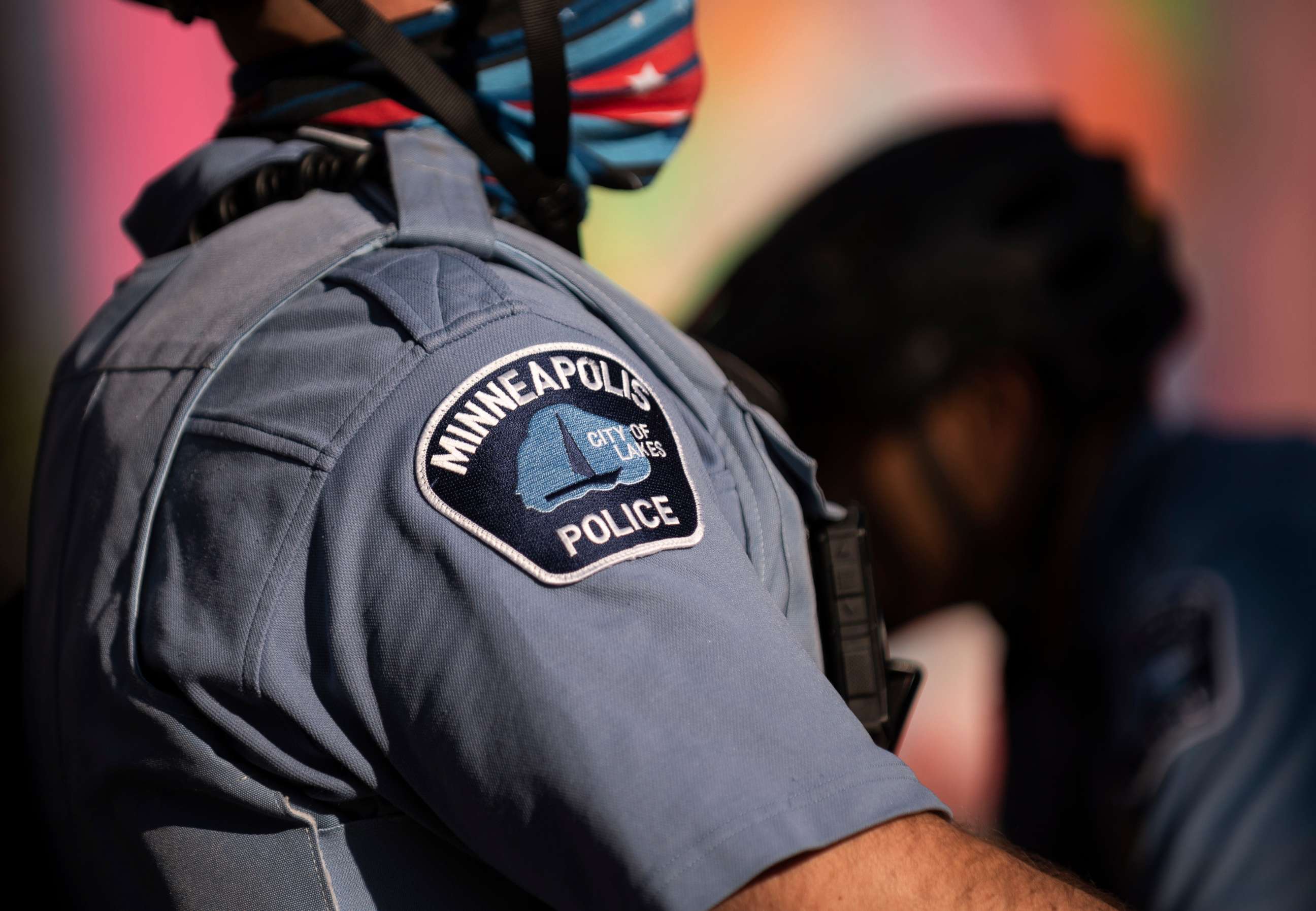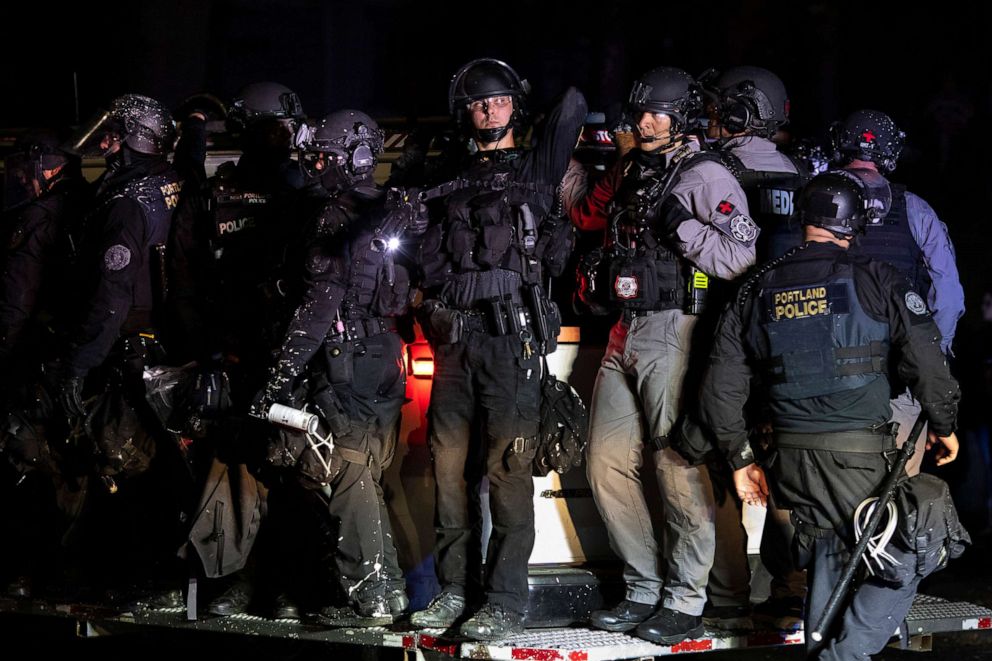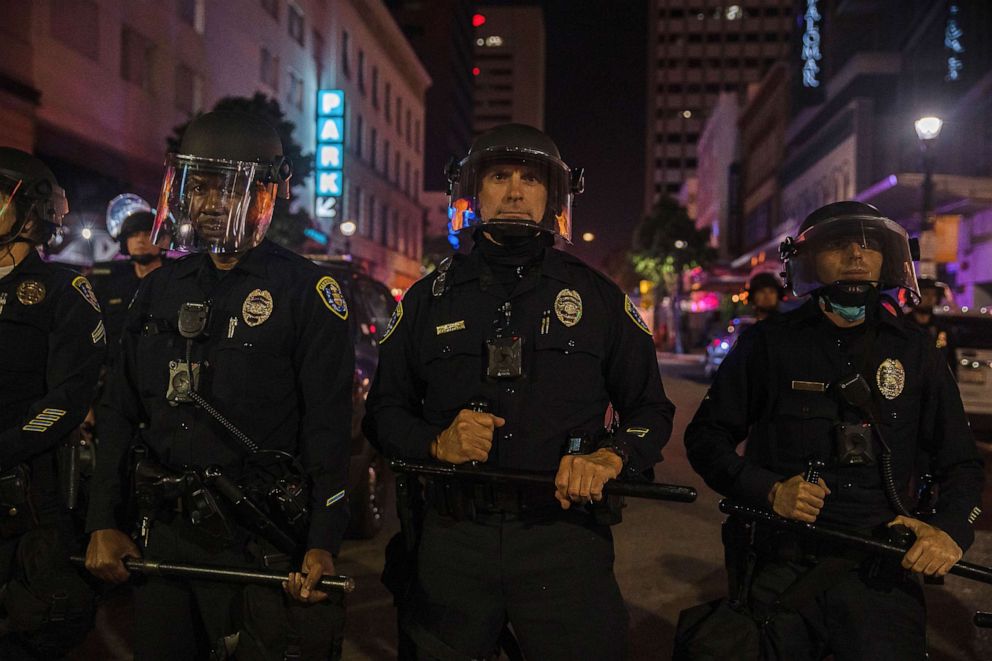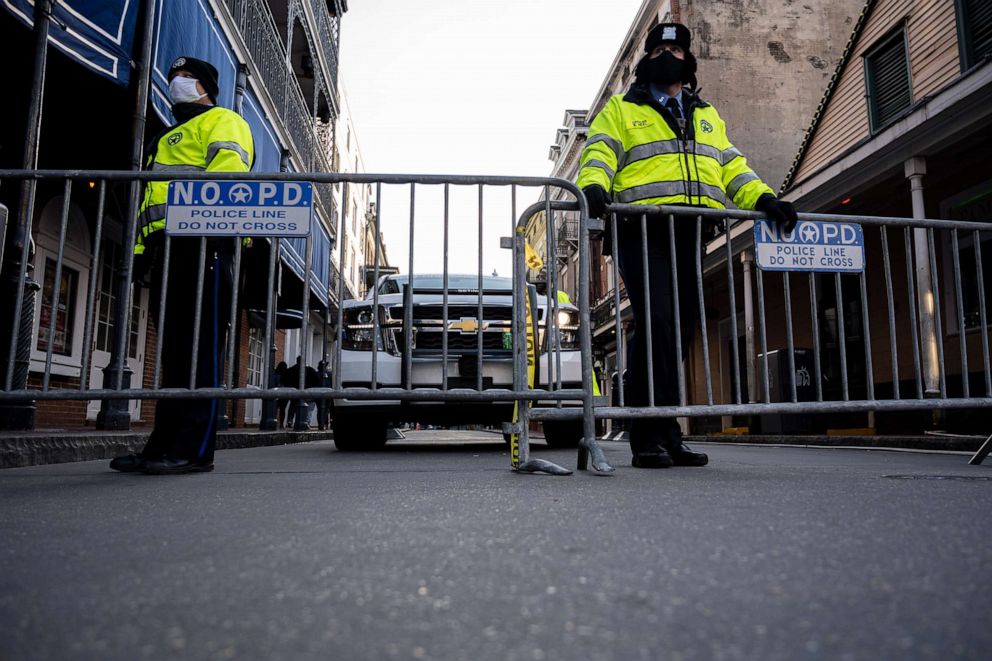How much do police officers mirror the communities they serve? ABC News looked at the data
Police diversity correlates to arrests among people of color, an analysis found.
Before joining the local police force eight years ago, Ryan Tillman, a young police corporal in Chino, California, was like many other Black youths in America: He was no friend of the police.
On multiple occasions, he had been harassed by cops because he looked "suspicious," as had those around him. When he had to find something to keep the bills paid because his wife had just become pregnant with their first child, and his father's friend, who was a police captain for many years, suggested he join the police force, his initial thought was, "I'm not working for the Man."
Tillman eventually accepted his calling and joined the Chino Police Department in 2013 -- and ever since, he has become one of the department's most vocal voices in bridging the gap between law enforcement and the community.
"It's very important to have the officers reflect the communities that they serve," said Tillman in an interview with Los Angeles ABC station KABC.
Tillman is currently one of eight Black officers out of 114 sworn officers in the Chino Police Department, according to data released by the agency. That's roughly the proportion of the Black population in the city -- but the rest of the police force is much whiter than the community, with other minority groups like Latinos and Asians significantly underrepresented within the department.
In the neighboring Los Angeles Metropolitan Police Department, sworn officers' racial and ethnic demographics better reflect the city's population. However, that's not the case in many other metropolitan areas across the country.
As more law enforcement agencies recognize the value of having a police force that mirrors its community, there continue to be widespread discrepancies in the demographics of departments across the country. Many report struggles to recruit a diverse candidate pool, which have been compounded by the COVID-19 pandemic. And some activists say diverse recruitment efforts may not be a panacea without additional reforms.
According to a new analysis of the U.S. Census Bureau's occupation reporting data by ABC-owned television stations and ABC News, in 99 of the country's 100 largest metropolitan areas, the share of police officers who are white is larger than the share of residents who are white.
In more than half of those metropolitan areas, the difference is at least 10 percentage points, the analysis found, and in at least five of the metropolitan areas, including the Durham-Chapel Hill area, the Portland-Vancouver-Hillsboro area, and the Las Vegas-Henderson-Paradise area, law enforcement officers were whiter than their communities by more than 20 percentage points.

In the Minneapolis metropolitan area, where former police officer Derek Chauvin was recently convicted of murder in the death of George Floyd, about 26% of the people are racial and ethnic minorities. Yet people of color hold fewer than 12% of police jobs across 15 counties in the metropolitan area, which includes St. Paul, Bloomington and a dozen surrounding counties in Minnesota and Wisconsin.
An ABC News analysis of 2019 arrest data shows that in the Minneapolis metropolitan area, Black people were about five times more likely to be arrested by police than white people.
The differences aren't just Black and white. In the San Jose, California, area, where 36% of people are Asian-American, only 10% of police are, the analysis shows.
Largely white police forces
In the Portland metropolitan area, which includes Portland and six surrounding suburban counties in Oregon and Washington, 28% of the residents are people of color, but 93% of the police officers are white, the analysis shows. Every single racial minority group is under-represented across the dozen police forces assigned to serve them. For example, Latino officers make up just 2% of the forces while Latinos make up 12% of the population in the area.
Shawn Campbell, the chair of the Portland Police Bureau's Training Advisory Council, a voluntary community advisory group, told ABC News that there have been significant racial and ethnic inequities in police stops, use of force, and arrests in Portland over the years, which he said are driven by officer bias, bias in other parts of the legal system, biases of the public requesting police services, and deep-rooted socioeconomic inequalities.
Data released by the city of Portland shows that the Portland Police Bureau is less white compared to the police forces of the larger surrounding metropolitan area, and that the portion of white officers has gradually gone down over the past decade, from more than 86% to roughly 83%. But it's still whiter than the community it serves.

Portland Police Bureau Public Information Officer Sgt. Kevin Allen told ABC News that prior to last year, the bureau was heavily recruiting a diverse workforce and "making great strides in that area," but it's since been faced with a significant reduction in operating budget. Allen said this will "likely have an impact on recruitment of historically marginalized and minority communities" because the agency is competing with other public safety agencies.
"We recognize the community wants to see a police department that reflects the diversity of our community," Allen said. "But there is no timeline when that may happen."
In the Durham-Chapel Hill metropolitan area, 46% of the residents are people of color, but only 23% of the sworn officers that serve in the area are people of color.
Much of that discrepancy comes from Durham, where census data shows that less than 40% of the city's residents are white -- while nearly 67% of the city police department's sworn officers are white, according to data released by the city. The Black population makes up close to 40% of the city, but only 24% of the department's sworn officers are Black. However, there are far more Black non-sworn members of the department -- 42% -- which more closely reflects the city's population.
This trend is mirrored in the Durham Police Department's recruitment reports from the past few years, in which the majority of the applicants are white, with many of them coming from outside the city. In the first quarter of 2020, for example, out of 42 total applicants, 21 were white, with only two from Durham. Fourteen applicants were Black, with eight of them being Durham residents, and seven of them were Latinos, with only one of them from Durham.
Lt. G. L. Minor from the department's Public Affairs Unit told ABC News that "attrition can impact the overall racial demographics of our department at any given time," but that "it is the Durham Police Department's goal to recruit officers who reflect the demographic composition of the City of Durham."
Minor said recruiting officers attend numerous job fairs, community events and career symposiums each month in an effort to attract well-qualified applicants, and hold regular "open houses" specifically marketed toward local applicants.
Overall, the ABC analysis showed that in the 100 largest metro areas, the more diverse police officers were across a region, the smaller the disparity in arrest rates between Black people and white people -- though a number of other factors might have influenced arrest numbers. For example, in the metro areas where 90% of officers were white, Black people were about five times more likely to be arrested than white people. In the metro areas where at least half of all police officers were people of color, Black people were only about twice as likely to be arrested.
Reflection of the community
There are several metropolitan areas that have police forces that are more of a reflection of the communities they serve, the analysis by ABC-owned television stations and ABC News shows.
In the Jackson, Mississippi, region, about half of the population is Black. Across seven counties in the Jackson area, more than half of cops are Black, too.
In the New Orleans region, 49% of residents are people of color, and so are 49% of police officers.
In the San Diego area, 55% of residents are people of color, and 56% of police officers are.
Similar numbers were seen across the metropolitan areas of Baltimore, Honolulu and San Antonio.
In the San Antonio-New Braunfels region, the nonwhite population is 68%, and the nonwhites on the police force make up 63%.
"It's not luck; it's through hard work and having everybody committed, from senior leadership down to community stakeholders," Lt. Jesse Salame, deputy chief of staff for the San Antonio Police Department, told ABC News. "It is important to have the makeup of the community that you're serving, because that's a basic level of understanding. We put a lot of pride into that, and we continue to work on that, too, knowing that that's an important aspect of everything that we're doing."
In San Antonio, the majority of the population -- 64% -- is Hispanic, based on the 2019 U.S. Census estimates. The majority of the San Antonio Police Department's sworn officers -- 53% -- are also Hispanic, based on the most recent sworn officer demographic data.
A lot of the department is also from San Antonio, Salame said.
"They go back and work some of the areas that they maybe grew up in or are familiar with, and I think that makes them better officers," he said. "Where a lot of departments have seen some of that disconnect or a lot of departments have had problems is where you've got people that are not from that community, they don't live in that community, and so they have no connection to that community."

Salame said the San Antonio Police Department works with different community and religious organizations to recruit officers -- and they also work with the military, as the city is home to four military installations.
One area the department is working to improve is its numbers for female officers. As of March 2, about 11% of sworn officers on the force, including cadets, were female.
"Our biggest push for a long time has been attracting more female recruits, and we've been able to do that," Salame said. "We're right about the national average for the percentage of female recruits. Of course we want to be higher."
Recruitment challenges
As law enforcement agencies look to diversity, many are having trouble hiring, in what the Police Executive Research Forum has called a "workforce crisis."
In a 2019 survey by the organization, about 63% of respondents said the number of applicants applying to become police officers has decreased significantly or slightly compared to five years ago. Respondents, in particular, said they were having difficulty hiring minority, female and bilingual candidates.
In Las Vegas, where non-Hispanic white officers make up more than 58% of the city's police force, even though just 43% of the city's residents are white, the Metropolitan Police Department says the disparity is not from a lack of trying.
"I will 100% admit that we're not where we want to be, and we will continue to work to get to those numbers until we can hopefully get at least as close as possible to it," Lt. Patricia Cervantes, who is part of the Las Vegas Metropolitan Police Department's Office of Human Resources, Background Section, told ABC News.
Cervantes said the department has been working closely with multiple cultural advisory groups to connect with communities of color and to actively recruit from them. But one of the major hurdles, she said, is cultural reluctance to join the police force in some communities.
"We've had kids that are like, 'I want to be a cop,' and they apply and they start getting through the process, and we've had people leave the academy because they're like, 'My family just doesn't want me to be part of this anymore. My parents don't agree with this,'" Cervantes said.
"I was born here and I love my community, and in my 20-year career, every day is trying to do the right thing for my community," Cervantes said. "And I think the majority of law enforcement is that. But unfortunately, the narrative being pushed out there is sometimes hard to get over."
In some cases, agencies might not know the racial or ethnic identity of their recruits, making it difficult to know if they indeed are a reflection of their community.
Since 2016, the San Jose Police Department has been reporting its recruitment activity semiannually after a 2015 city audit of hiring practices found disparities in the representation of the force, particularly among Asian and Hispanic populations, and recommended the department take steps to increase the diversity of its candidate pool.
According to the department's latest report from September 2020, a vast majority -- 87% -- of recruits in its 38th academy class, which graduated in February, didn't report their ethnicity. "As a result, the demographics of new police officers and lateral police officers are difficult to compare against current city demographic data and past department demographic data," the report stated.
Recruits aren't required to specify their ethnicity, and in recent years the number of those choosing not to report it has grown, the department said.
"We want to see how we're doing," Stephen Donahue, then-commander of recruiting and background unit for the San Jose Police Department, told the San Jose City Council during a September presentation on the latest recruiting report. "We can't statistically measure how well we're doing on recruiting ethnicities, because they're not reporting their ethnicity."

Among the 41 recruits in the department's newest academy class, which graduates at the end of this month, there are Hispanic, Ukrainian, Vietnamese and Malian graduates, and 11 different languages beyond English represented, the department said in a statement to ABC News.
"As you can see, we are hiring very diverse police recruits, and have been for many years," a spokesperson said.
According to its latest recruiting report, as of June 10, 2020, the San Jose Police Department's demographics were 41.84% white, 23.86% Hispanic/Latino, 14.74% Asian American/Pacific Islander, 3.42% African American and 0.61% Native American. An additional 15.3% was not specified.
By comparison, the demographics of San Jose residents are 25.7% white, 31.6% Hispanic/Latino, 35.9% Asian American/Pacific Islander and 3% African American, according to the U.S. Census' July 2019 population estimates.
The COVID-19 pandemic has disrupted some recruitment efforts, with many job fairs being canceled and college campuses across the country at reduced capacity, officials say.
"Our ability to recruit has been severely impacted over the last year by COVID-19," Northam, of the Chapel Hill Police Department, said. "Prior to the pandemic, we would attend job fairs and recruit from various Basic Law Enforcement Training academies around the state. Over the course of the last year, we have not done any of this. As a result, we have not been able to attend any recruitment events for more than a year now."
As COVID-19 restrictions continue to ease, Northam said the department hopes to resume its recruiting efforts "and continue to attract a diversified workforce."
Is police expansion the solution?
The question of whether diversity in the police force helps change policing outcomes has been debated over multiple studies. A recent study that closely looked into the Chicago Metropolitan Police's data while controlling for specific circumstances found that race and gender have a significant effect on officers' interactions with civilians, and that white officers make more arrests and use force more often, especially against Black people.
However some studies have found "no credible evidence" of officers of different racial or ethnic backgrounds performing differently due to a number of other factors, such as agency culture.
Considering this, some advocacy groups say that recruiting more officers of color and expanding the police may not be the solution to the problem.
Campaign Zero co-founders Deray McKesson and Samuel Sinyangwe, among the most vocal police reform activists in the country, told ABC News the arguments around trust and community-police relations have been "amorphous." Instead, their focus has been on outcomes -- what actually reduces police use of force and racial disparities.
Sinyangwe argues that diversifying the police force by expanding the police budget and hiring more officers is "not the right approach" when the police budget may pay the salaries and benefits of officers who live outside the areas that they serve, further driving investments away from the community.
"The other approach is to cut the police force, to cut the officers with the largest records of misconduct, the most complaints against them, the largest racial disparities in arrests and the most police shootings," Sinyangwe said. "Those tend to be white male officers. And you would diversify the police force by cutting those officers."
Sinyangwe and McKesson also advocate for more alternative response programs that are more likely to better connect with communities and less likely to engage in use of force.
Several cities across the country have implemented alternative policing programs, including Portland, where the police bureau has been piloting a non-police mental health response program as well as an unarmed public safety program.
"If there are issues with recruiting, that speaks to the problems in law enforcement -- the distrust of law enforcement and the impact that law enforcement has had on communities," Sinyangwe said. "There are other pathways to achieving impact that don't involve signing up to be the police."
ABC News' Halley Frager contributed to this report.




